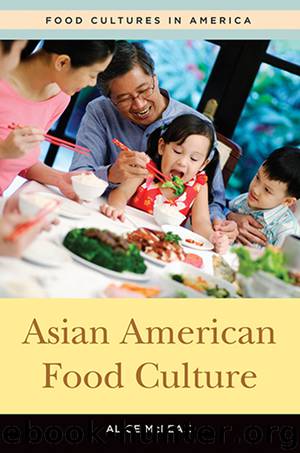Asian American Food Culture by McLean Alice L.; McLean Alice L ;

Author:McLean, Alice L.; McLean, Alice L ; [Alice L. Mclean]
Language: eng
Format: epub
ISBN: 2007441
Publisher: ABC-CLIO, LLC
Cooking Equipment
Wok: Arguably the world’s most versatile and efficient cooking instrument, the wok has earned a valued place among home cooks and chefs throughout the United States. Invented by the Chinese, wok cookery migrated throughout East and much of Southeast Asia, where it serves as the primary cooking vessel. Because the wok works less efficiently on an electric burner, many Asian Americans with an electric stove use Western pots and pans rather than woks. More recently, however, flat-bottomed woks that have been designed for use on an electric burner have become readily available. Typically a round-bottomed pan, the wok requires little oil in stir-frying as the oil collects at the bottom. The small uniform cuts of meat and vegetables used in stir-frying enable the ingredients to be seared quickly at high heat, a technique that maintains and enhances the natural flavors of food; lower temperatures require longer cooking times during which flavors can be dulled or watered down. The wok’s sloped sides lead to less spillage and also encourage foods to slide back to the bottom rather than sticking to the sides of the pan.
Woks must be seasoned before first use in order to seal the porous metal with a layer of fat so that foods do not stick to the surface. Wok sizes vary depending on their main purpose and the quantity of food regularly cooked in them. They come with two looped handles or a single long handle. Woks are made from a variety of metals, but the most prized are cast-iron or carbon steel. Cast iron skillets in the United States tend to be heavy and difficult to maneuver, although lighter versions are imported from China. Carbon steel woks heat and cool more quickly than cast iron, which prevents food from overcooking. They may be hand-hammered or factory-made and do not come with flat bottoms. Because of their shape, woks can function as a pot or as a pan. As a result, they are not only used for stir-frying, but are also used for deep-frying, poaching, braising, boiling, steaming, and smoking.
Wok Rings and Wok Lids: The circular metal frame that holds the wok in place is known as a wok ring. It is needed when steaming, boiling, or deep-frying in the wok. It may also be used to secure a round-bottomed wok for use on an electric burner, although the food will not cook as quickly and efficiently as it will on a gas burner. Wok rings and lids are typically made from aluminum. Rounded lids are the norm for wok cookery, as the curvature means that less condensation will form on the lid and drip onto the food below. Lids are essential for stewing, steaming, or smoking foods.
Wok brush: This wooden brush with wide, thin bristles is used to clean a wok.
Wok spatula and ladle: A round-edged spatula is preferable for use with a flat-bottomed or a shallow wok. For deeper woks, a ladle works best as it fits the steeper curve better than the smaller spatula.
Download
This site does not store any files on its server. We only index and link to content provided by other sites. Please contact the content providers to delete copyright contents if any and email us, we'll remove relevant links or contents immediately.
Whiskies (Collins Gem) by dominic roskrow(45027)
101 Whiskies to Try Before You Die by Ian Buxton(44734)
World's Best Whiskies by Dominic Roskrow(44686)
Whiskies Galore by Ian Buxton(41802)
The Fast Metabolism Diet Cookbook by Haylie Pomroy(21045)
Chic & Unique Celebration Cakes by Zoe Clark(19936)
Craft Beer for the Homebrewer by Michael Agnew(18123)
The Bone Broth Miracle: How an Ancient Remedy Can Improve Health, Fight Aging, and Boost Beauty by Ariane Resnick(16529)
For the Love of Europe by Rick Steves(12646)
Tools of Titans by Timothy Ferriss(8186)
A Court of Wings and Ruin by Sarah J. Maas(7620)
How to Be a Bawse: A Guide to Conquering Life by Lilly Singh(7360)
The Institute by Stephen King(6916)
Cravings: Recipes for All the Food You Want to Eat by Chrissy Teigen & Adeena Sussman(6731)
Chowders and Soups by Liz Feltham(6705)
Wiseguy by Nicholas Pileggi(5648)
The Last Wish (The Witcher Book 1) by Andrzej Sapkowski(5373)
Spare by Prince Harry The Duke of Sussex(5054)
Room 212 by Kate Stewart(5014)
